全文HTML
--> --> -->NO3自由基白天迅速光解, 寿命极短, 通常认为仅在夜间累积[4], 由于NO3自由基在大气含量极低, 夜间NO3自由基浓度仅为几pptv至几百pptv, 且易损耗、活性强, 准确测量难度较大, 需要测量设备具有很高的探测灵敏度和稳定性, 目前国际上公认的 NO3 自由基测量方法主要有以下几种: 差分光学吸收光谱法(DOAS)[5]、激光诱导荧光光谱法(LIF)[6]、化学电离质谱法(CIMS)[7]、基质隔离电子顺磁共振光谱法(MI-ESR)[8]、腔衰荡光谱技术(CRDS)[9]及宽带腔增强吸收光谱技术(BBCEAS)[10]. 光腔技术(CRDS技术和BBCEAS技术)具有结构简单、造价低、便携性好、精度高等优点, 并方便应用于地面、高塔以及机动车、轮船、飞机等移动平台进行测量, 成为目前测量NO3自由基最具有潜力的技术. 如美国国家海洋和大气管理局Wagner等[11]采用脉冲CRDS技术实现机载测量NO3, N2O5, O3, NO和NO2, 国内中科院安光所谢品华团队采用CRDS技术开展了NO3相关研究工作[9,12,13], 研制的基于CRDS技术的NO3测量系统探测灵敏度为2.3 ppt, 时间分辨率为2.5 s.
宽带腔增强吸收光谱技术是在腔衰荡吸收光谱技术的基础上发展而来, 经过十余年的发展, BBCEAS技术已成功用于多种大气痕量气体的高灵敏测量, 例如NO2[14-16], N2O5[17], I2[18], IO[18], HONO[19-22], CHOCHO[23,24], O3[25]等, 也开展了NO3自由基相关研究工作[10,26,27], 如德国海德堡大学Meinen等[28]采用腔增强吸收光谱技术在实验室测量NO3自由基, 积分时间为300 s情况下, 探测灵敏度为6.3 pptv. 法国滨海大学Wu等[29]采用BBCEAS技术在烟雾箱中同时测量NO3, NO2和O3, NO3的探测灵敏度为7.9 pptv, 时间分辨率为60 s. 北京大学Wang等[10]采用BBCEAS技术测量了北京地区NO3自由基, 仪器灵敏度为2.4 ppt, 时间分辨率为1 s. 本文将介绍课题组在原有工作基础上开展的宽带腔增强吸收光谱技术应用于大气NO3自由基的测量研究, 进行了LED光源测试, 镜片反射率标定, 有效腔长标定, 光谱拟合分析和Allan方差分析等工作, 最后通过实际大气NO3自由基观测实验来验证自主研制腔增强吸收光谱测量系统性能.
2.1.BBCEAS的测量原理
宽带腔增强吸收光谱技术基于各种痕量气体对光辐射独特的“指纹”特征吸收实现定性和定量测量, 该技术使用由一对高反镜组成的光学腔, 以约1 m的光学腔通过光子在两片高反镜之间来回反射, 实现几公里甚至几十公里的有效吸收光程, 因此宽带腔增强吸收光谱技术能够实现很高的探测灵敏度, 并且宽带光谱能够覆盖痕量气体完整的吸收峰, 具有较强抗干扰能力等特点. 由于腔增强吸收光谱技术的有效吸收光程很长, 通常采用过滤膜过滤气溶胶等物质, 腔内光强的改变主要考虑痕量气体的吸收以及瑞利散射等, 基本上可以排除气溶胶的米散射. 宽带腔增强吸收光谱技术通过测量光学腔内待测气体吸收前后的光强变化和镜面反射率等来实现待测气体浓度的反演, Fiedler等[30]详细介绍了推导过程, 吸收系数







2
2.2.实验装置
研制的大气NO3宽带腔增强吸收光谱测量系统示意图如图1所示, 主要由LED光源、透镜、两端安装高反镜的光学腔和光谱仪等组成. LED发出的光通过消色差透镜准直后从腔体一端进入光学腔, 光束在光学腔内经多次反射吸收, 从另一端透射出去, 最终传输至光谱仪进行光谱分析. 图 1 基于红光LED的宽带腔增强吸收光谱系统示意图
图 1 基于红光LED的宽带腔增强吸收光谱系统示意图Figure1. The schematic diagram of broadband cavity enhanced absorption spectrometer based on red LED.
综合考虑光源光谱范围、高反镜的高反区域与NO3的吸收峰波段能够较好匹配, 确定测量NO3自由基的662 nm吸收峰来定量NO3自由基浓度, 选择中心波长约660 nm的LED(LZ1-00R202, LedEngin公司)作为宽带腔增强吸收光谱系统的光源, LED的半峰全宽约为18 nm. 由于LED光源的发射谱会随温度的变化而产生漂移, 因此光源的温控将直接影响光谱的稳定性. 若不对LED进行控温, 造成的LED的发射谱漂移将对NO3浓度反演产生较大影响[31]. 由于LED芯片尺寸很小, 产生的热量快速传输至散热片, 将PT1000温度探头安装于LED散热铝板内, 通过PID算法控制半导体制冷片的工作电流从而控制LED散热铝板的温度, 实现LED光源恒温, 控温效果达到0.01 ℃. 光学腔由两块高反镜组成, 设计为非共焦腔, 选用的高反镜(直径25 cm, 曲率半径1 m, Layertec公司 Laser mirror 102116)在620—680 nm波段内厂家标称反射率大于99.99%, 高反镜通过调整架固定于光学腔两端, 光学腔体采用PFA材质, 长度为53 cm. 各光学元件也需要考虑孔径匹配情况, 光学腔前后耦合透镜选择为1英寸直径的消色差透镜(60 mm焦距, Edmund公司), 选择数值孔径0.22的光纤(600 μm, Ocean Optics公司)和TEC制冷光谱仪(QE65 pro, Ocean Optics公司).
考虑国内的实际使用环境, 设计适合国内高颗粒物采样环境的采样气路, 实现对 NO3 自由基的高灵敏度低损耗测量. 通过增大采样气流, 减少气流在腔内的停留时间, 减少自由基采样损耗. 采样气流接触的采样管、各类接头、光学腔全部采用高纯度PFA材质, PFA材质的化学惰性也能够减少壁效应对测量结果的影响. 我国城市大气中颗粒物浓度相比于清洁地区通常较高, 而研制的宽带腔增强吸收光谱的吸收光程很长, 直接采样会导致气溶胶进入光学腔内, 气溶胶Mie散射消光会极大降低腔内吸收光程, 因此采样前使用聚四氟乙烯过滤膜来过滤气溶胶从而减少光学腔内Mie散射消光. 考虑到复杂采样环境, 为了进一步保护高反镜不受采样气流影响, 设计吹扫保护气路, 吹扫保护气流在高反镜与采样气流之间形成气帘, 从而保证高反镜反射率在测量过程中长期保持稳定, 因此BBCEAS实验装置通过三个质量流量计(CS200A, 七星华创公司)分别控制两路保护吹扫气路和一路采样气路, 尽可能保证气流在光学腔内的稳定. 大气采样过程中, 采样气路最大流速为5标准升每分钟(standard litre per minute, SLM), 两路保护吹扫气流保持于0.1标准升每分钟.
3.1.LED光源测试
宽带腔增强吸收光谱系统探测性能的关键在于高信噪比、高稳定性的待测气体吸收光谱信号的获取, 因此首先对采用的LED光源进行测试, 通过实验确定最佳工作参数. 选用可改变输出电流强度的恒流源对红光LED供电, 使用光谱仪测量LED的辐射光谱. 实验对比了不同驱动电流条件下的LED辐射谱强度(在电流测试时, 保持LED温度稳定), 测试结果如图2(a)所示, 在驱动电流小于1.5 A情况下, LED辐射谱强度随着电流的增加会有明显增加, 但超过1.5 A之后, 电流的增加对于NO3吸收峰处(662 nm)辐射谱强度增加的贡献减少, 光谱峰值红移明显, 因此实际使用中LED光源的电流确定为1.5 A.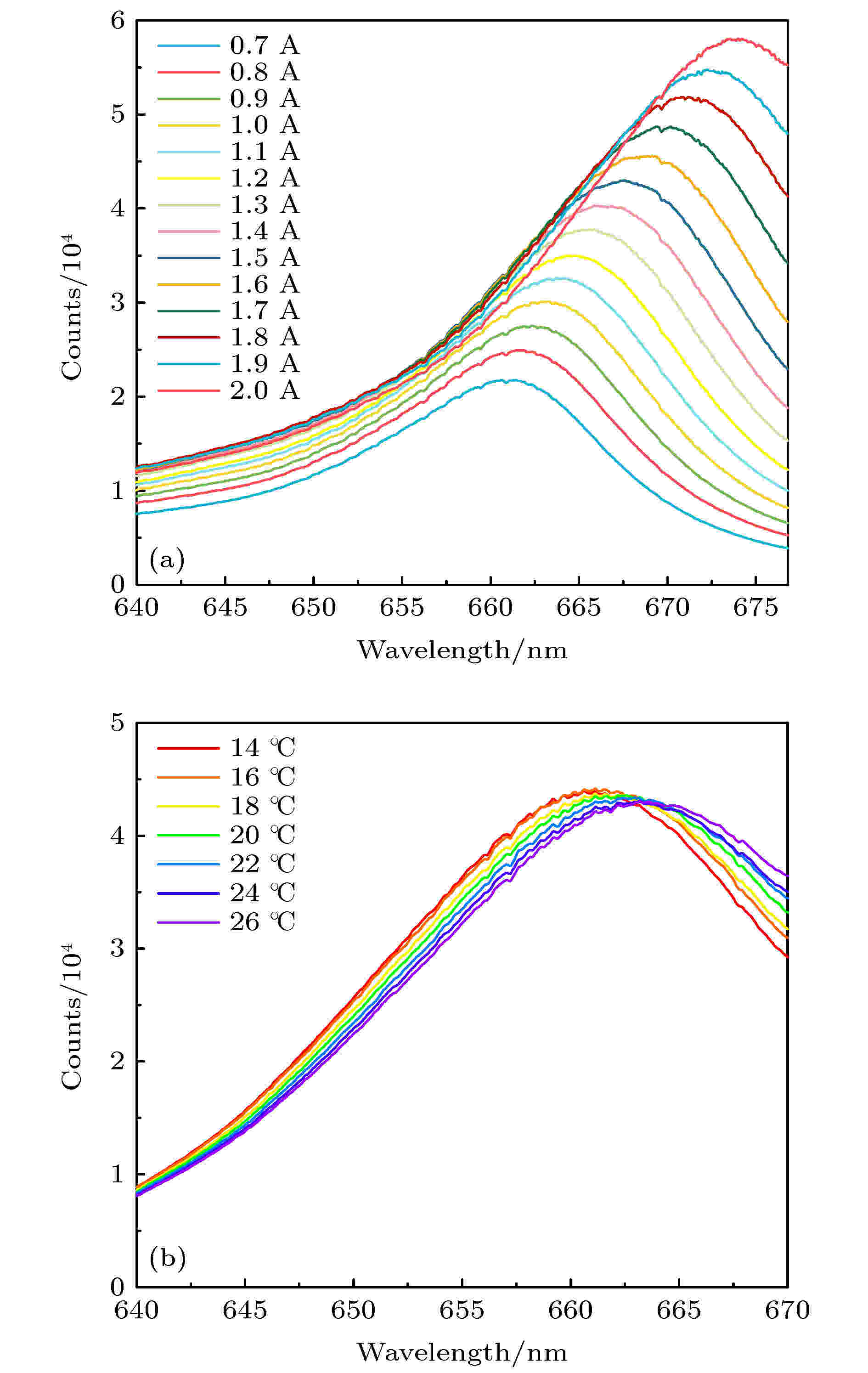 图 2 LED光源测试 (a) LED光谱随电流变化规律; (b) LED光谱随温度变化规律
图 2 LED光源测试 (a) LED光谱随电流变化规律; (b) LED光谱随温度变化规律Figure2. Test of the LED light source: (a) LED spectrum changes with the current; (b) LED spectrum changes with temperature.
LED光源已被证明光谱存在较明显的热漂移现象, LED光谱随着温度的提高, 中心波长会向红外波段发生漂移, 光谱强度也会发生一定改变. 因此, 对选用的LED进行温度测试(在温度测试时, 保持驱动电流稳定), 测试结果如图2(b)所示, LED的温度每升高1 ℃, 中心波长会向红外方向漂移约0.15 nm, 光强下降约0.19%, 可以通过温度控制来实现中心波长的调节, 最后LED温度确定为20 ± 0.01 ℃.
2
3.2.镜片反射率标定
宽带腔增强吸收光谱是一种相对的测量方法, 要从测量谱中反演出被测气体的浓度, 必须标定所采用的高反射率镜片的反射率随波长的变化曲线, 而镜片反射率的标定误差很大程度决定了最终的测量误差. Washenfelder等[32]提出了采用不同气体分子的瑞利散射差异性标定镜片反射率的方法, 并进行了详细的公式推导, 该方法标定镜片反射率操作简单, 可适用于多种波段, 其数据表达式如下:




进行宽带腔增强吸收光谱系统镜片反射率标定时, 分别将高纯氮气(99.9999%)和氦气(99.9999%)依次通入腔内, 光谱稳定后分别记录相应的光谱强度


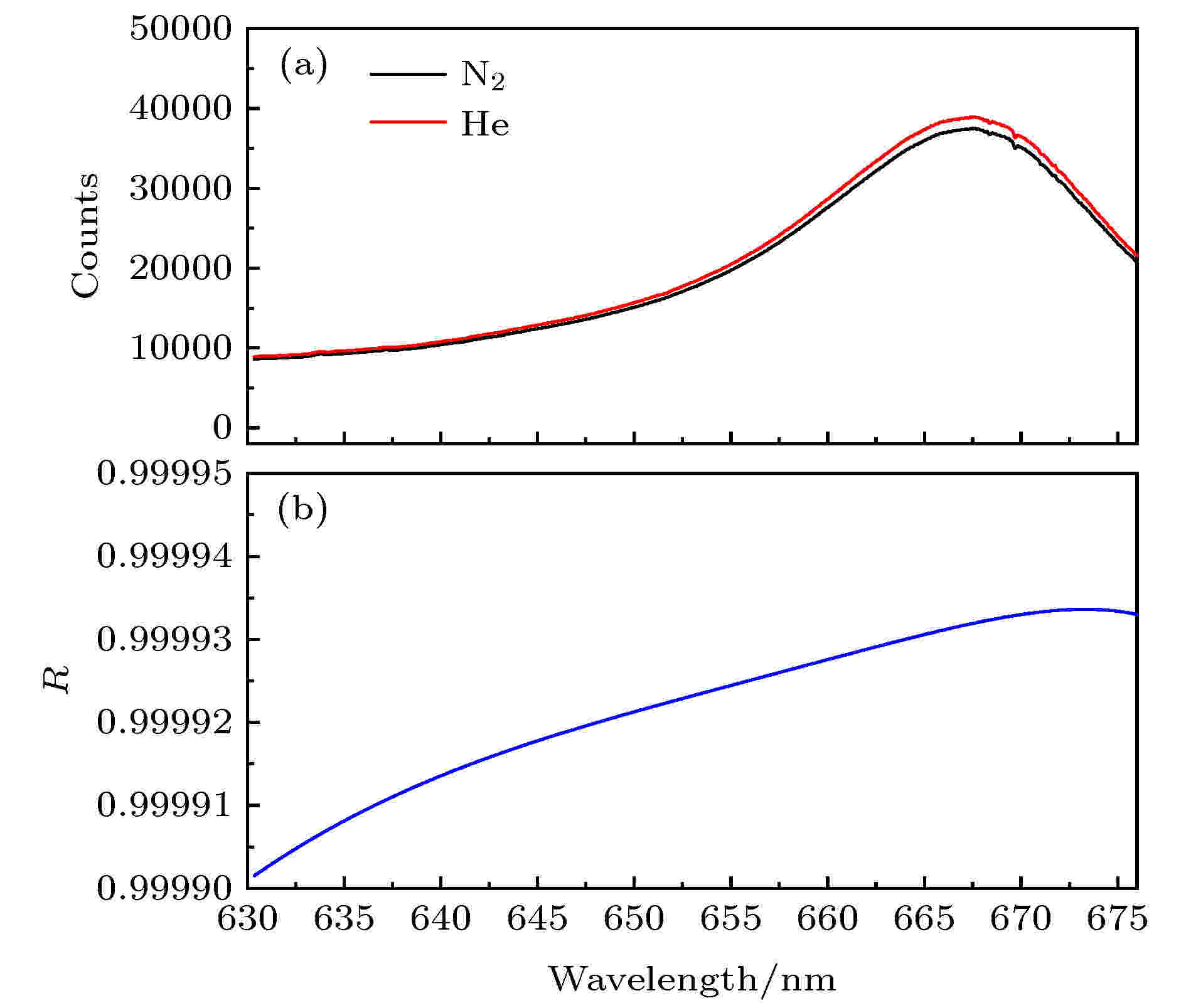 图 3 镜面反射率标定 (a)黑线是氮气谱, 红线是氦气谱; (b)蓝线为镜面反射率曲线
图 3 镜面反射率标定 (a)黑线是氮气谱, 红线是氦气谱; (b)蓝线为镜面反射率曲线Figure3. Calibrations of mirror reflectivity: (a) The black line is nitrogen spectrum, and the red line is helium spectrum; (b) the blue line is the derived curve of mirror reflectivity.
2
3.3.有效腔长标定
研制的宽带腔增强吸收光谱系统为了提高环境适应性, 设计了吹扫保护气路, 吹扫保护气流在高反镜与采样气体中间产生气帘, 确保高反镜表面不受污染, 但会导致有效腔长小于两片高反镜间的距离, 而有效腔长的准确标定也是影响待测气体浓度准确反演的重要因素.向腔内通入稳定浓度和流速的吸收气体, 通过测量有无吹扫气流时吸收气体反演浓度的比值, 来计算物理腔长与有效腔长比例是目前常用的有效腔长标定方法. 对于一台宽带腔增强吸收光谱系统, 所使用的光谱波段若覆盖多种痕量气体吸收, 通常认为只要对其中一种吸收气体进行测试, 其结果也满足于同时测量的其他气体, 考虑到我们使用的光谱波段覆盖NO3自由基, 水汽和NO2吸收峰, 其中稳定浓度的NO2样气相对容易获得, 因此通过测量稳定浓度的NO2在有无吹扫气流时的反演结果来标定有效腔长. 有效腔长标定过程如下: 采用Messer公司提供的10 ppmv NO2标准样气通过气体稀释仪与高纯氮气混合稀释后以恒定流速(3 SLM)通入光学腔, 测量打开吹扫保护气流(0.1 SLM)和关闭吹扫保护气流时NO2的浓度变化, 根据公式(3)计算有效腔长.
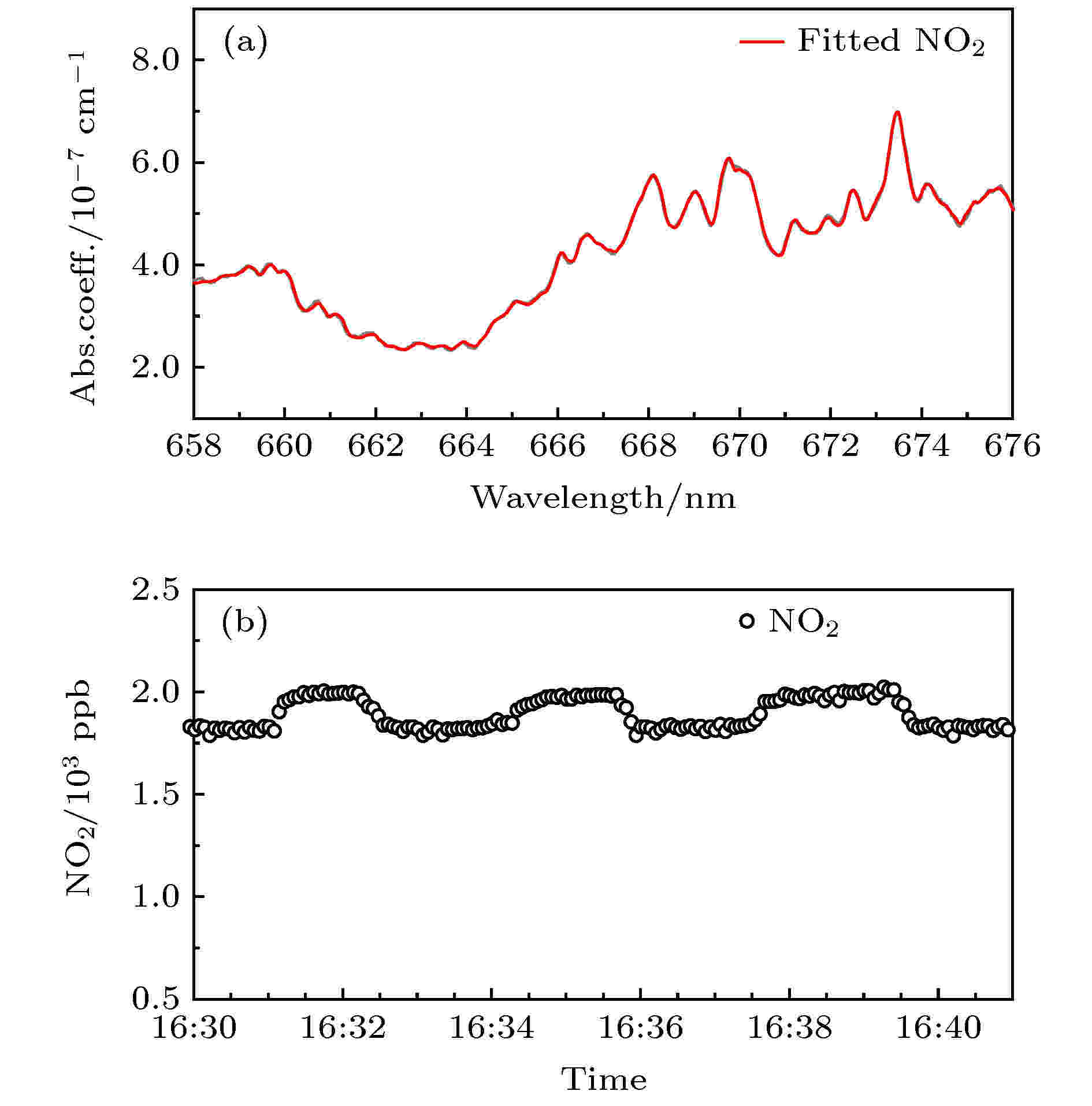 图 4 有效腔长标定 (a)NO2光谱拟合结果(b) NO2浓度时间序列
图 4 有效腔长标定 (a)NO2光谱拟合结果(b) NO2浓度时间序列Figure4. Calibration of effective cavity length: (a) Results of NO2 spectral fitting; (b) time series of NO2.
2
3.4.NO3的浓度反演
拟合波段的选择需要综合考虑待测气体吸收峰位置、LED光源峰型、高反镜的高反区域、待测气体之间的相互干扰等众多因素, 通过不断测试和对比, NO3拟合波段选择为655.5—668 nm, 该拟合波段除了NO3, 也同时有NO2和水汽的吸收. 由于大气中的水汽浓度相比于痕量气体浓度高很多, 而水汽的吸收线宽小于光谱仪的分辨率, 导致水汽存在饱和吸收现象, 采用传统宽带腔增强吸收光谱拟合方法很难将水汽吸收完全扣除, 若无法扣除水汽干扰, 光谱拟合过程中较大的剩余结构会掩盖大气NO3的吸收结构, 导致大气NO3的探测灵敏度下降. 此外, 由于待测气体NO3自由基活性很强, 极易碰撞损耗, 无法通过干燥装置等在不影响NO3的前提下滤除水汽, 因此, 水汽成为宽带腔增强吸收光谱技术测量大气 NO3的重要干扰因素.目前对于宽带腔增强吸收光谱技术扣除水汽干扰开展了较多研究, 有NO滴定方法[10]和水汽截面迭代计算方法[17]等, 本研究尝试采用白天大气测量谱作为背景谱, 来减少宽带腔增强吸收光谱技术测量NO3自由基过程中水汽的影响, 该方法常在长光程差分光学吸收光谱技术(LP-DOAS)测量大气NO3自由基时使用[34]. 由于NO3自由基白天浓度极低, 可以认为白天的大气测量谱包含水汽和NO2吸收信息, 但不包含NO3自由基吸收, 该方法假定傍晚与夜间的水汽浓度以及温度变化在一定范围内, 选择白天测量谱作为背景谱对夜间测量谱进行光谱拟合反演, 能够有效扣除大部分水汽吸收的干扰. 开展大气NO3测量时, 选取日落前的大气测量谱作为背景谱, 通过(1)式对夜间大气NO3测量谱进行光谱反演, 获得吸收系数

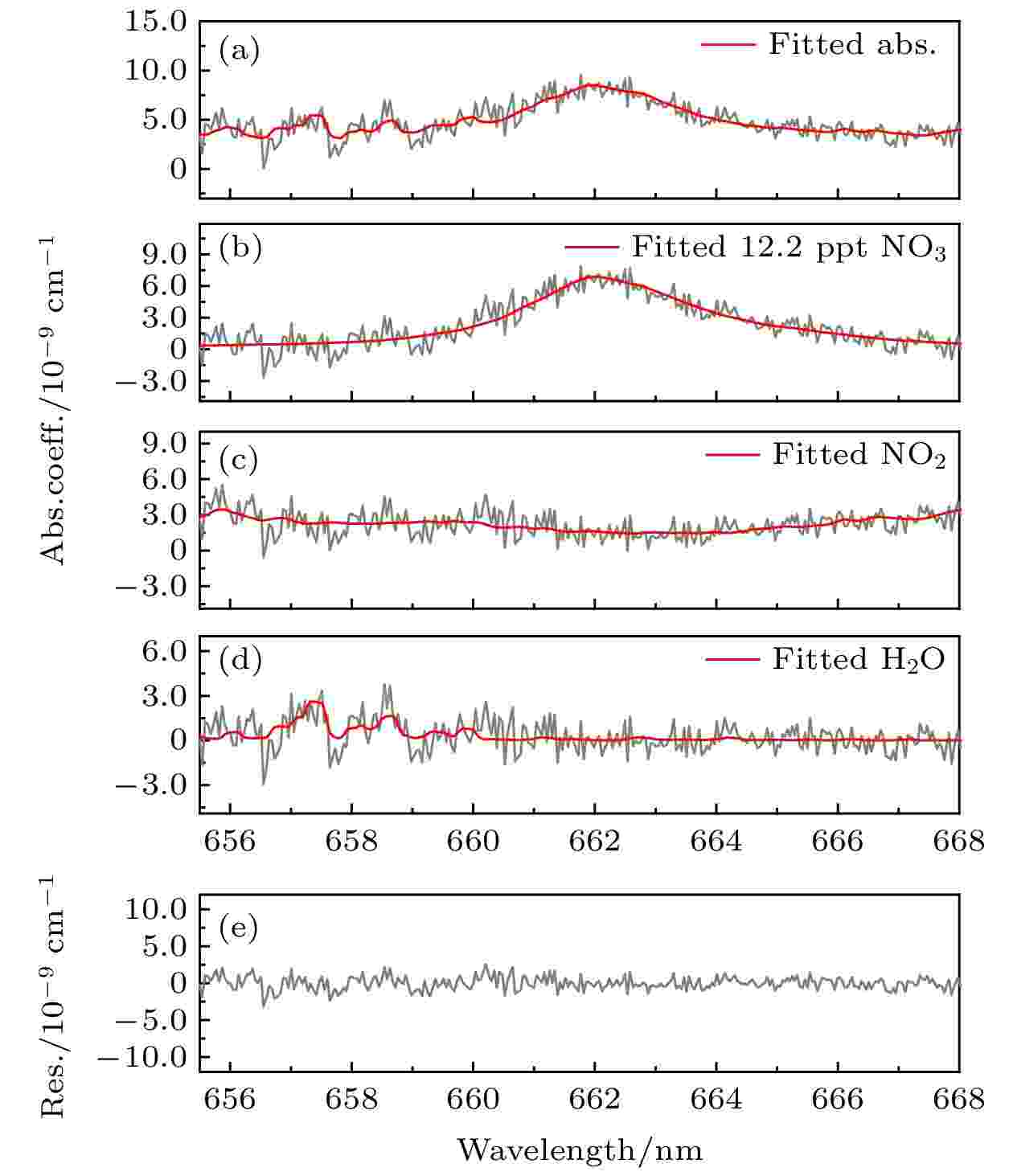 图 5 实测大气中NO3的光谱反演实例 (a) 灰线是实测大气的吸收谱, 红线是拟合谱; (b) 灰线是NO3的吸收谱, 红线是拟合谱, 反演浓度12.2 ± 0.61 pptv; (c) 灰线是NO2的相对吸收谱, 红线是拟合谱; (d) 灰线是水汽的相对吸收谱, 红线是拟合谱; (e) 拟合残差谱, 标准偏差为8.7 × 10–10
图 5 实测大气中NO3的光谱反演实例 (a) 灰线是实测大气的吸收谱, 红线是拟合谱; (b) 灰线是NO3的吸收谱, 红线是拟合谱, 反演浓度12.2 ± 0.61 pptv; (c) 灰线是NO2的相对吸收谱, 红线是拟合谱; (d) 灰线是水汽的相对吸收谱, 红线是拟合谱; (e) 拟合残差谱, 标准偏差为8.7 × 10–10Figure5. Spectral inversion example of NO3: (a) The grey line is the absorption spectrum of the measured atmosphere, and the red line is the fitting spectrum; (b) the gray line is the absorption spectrum of NO3 and the red line is the fitting spectrum, concentration of NO3 is 12.2 ± 0.61 pptv; (c) the grey line is the relative absorption spectrum of NO2, and the red line is the fitting spectrum; (d) the gray line is the relative absorption spectrum of water vapor, and the red line is the fitting spectrum; (e) the gray line is residual spectrum, and the standard deviation of residual spectrum is 8.7 × 10–10.
2
3.5.系统稳定性及检测限分析
系统的稳定性影响着系统的灵敏度, 因为一个理想稳定系统的信号理论上可以被无限次地平均, 从而达到极高的灵敏度, 但实际上系统仅仅是在一定的时间范围内稳定. 对于宽带腔增强吸收光谱系统, 系统稳定性主要受温度、供电电流、材料损耗等影响, 光源、光谱仪探测器以及系统器件的细微改变均会导致吸收光谱发生一定变化.采用Allan方差对研制的用于NO3测量的宽带腔增强吸收光谱系统整体性能进行描述, 腔内通入0.1 SLM流速的高纯氮气, 待系统稳定后, 连续记录10000条光谱, 每条光谱积分时间为4 s. 将记录的10000条光谱分成M组, 每组包含N条光谱(N = 1, 2, 3, ···, 1000; M = 10000/N = 10000/1, 10000/2, ···, 10000/1000). 将第i组的N条光谱的平均谱作为Ii, 拟合出相应浓度

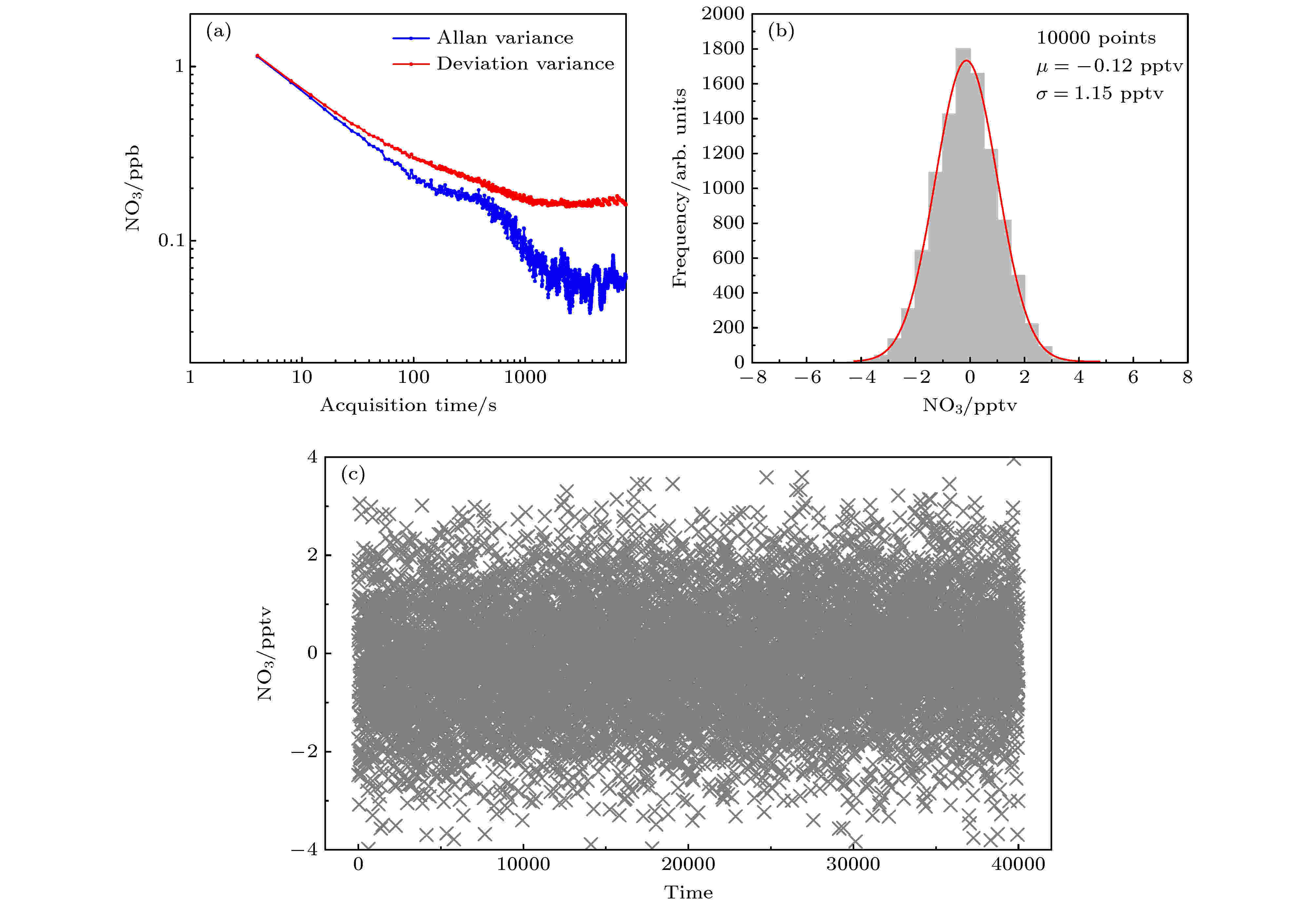 图 6 检测限分析 (a) NO3的Allan方差和标准方差随平均时间的变化曲线; (b) 4 s积分时间情况下的NO3浓度统计图; (c) 4 s积分时间情况下的NO3浓度时间序列
图 6 检测限分析 (a) NO3的Allan方差和标准方差随平均时间的变化曲线; (b) 4 s积分时间情况下的NO3浓度统计图; (c) 4 s积分时间情况下的NO3浓度时间序列Figure6. Analysis of detection limit: (a) Change curves of Allan variance and standard variance of NO3 with average time; (b) statistical chart of NO3 concentration with 4 s integration time; (c) time series of NO3 concentration with 4 s integration time.
NO3采样总传输效率估算误差主要来自于PFA材质对NO3的损耗系数标定误差, 估计为10%; NO3吸收截面误差来自于标准吸收截面的测量误差, 估计为10%; 镜面反射率标定误差来自于氮气和氦气瑞利散射系数误差, 估计为5%, 光谱拟合误差主要来自于光谱拟合时的噪声, 估计为5%; 有效腔长标定误差主要来自于拟合NO2的误差以及标气的稳定性, 估计为5%; 根据误差传递函数, 总测量误差估算约为16%.
2
3.6.实际大气NO3测量
为验证仪器性能, 开展实际大气NO3的测量, 研制的用于大气NO3测量的宽带腔增强吸收光谱系统放置于合肥市西北郊的中科院安徽光机所综合实验楼6楼, 测量系统距离地面大约20 m, 采用一根约3 m长、内径4 mm、外径6 mm的PFA采样管对实际大气进行抽气采样, 采样气流选择为3 SLM. 根据实际使用的采样管长度和采样气流, 计算采样气流在采样管内停留时间约为0.5 s, 采样气流从进入高反腔到其中间的停留时间约为2.2 s, 根据文献测量的PFA材质对NO3的损耗系数[10], 计算该宽带腔增强吸收光谱系统总的NO3传输效率为(54±5)%. 另有一套开放光路差分吸收光谱装置[38]进行大气同步测量, 能够提供大气SO2, O3, NO2等辅助数据. 图7为2020年5月23日 16:00到5月24日 6:00的O3, NO2, SO2, NO3的测量结果, 测量期间O3日落后逐渐下降, O3浓度最高值为54.2 ppbv, 浓度最低值为12.4 ppbv, 平均浓度为36.3 ppbv; NO2浓度在夜间积累, NO2浓度最高值为30.6 ppbv, 浓度最低值为0.1 ppbv, 平均浓度为8.2 ppbv; NO3最高值为23.4 pptv, 主要出现于19:00 ~ 23:00, 该时段NO3平均值为11.56 pptv, 22:24后NO3浓度逐渐降低, 23:00以后NO3浓度趋近于仪器探测限. 研制的用于NO3测量的宽带腔增强吸收光谱系统运行稳定, 光谱拟合残差较小, 测量结果符合NO3变化规律, 表明该设备能够进行实际大气NO3的有效测量.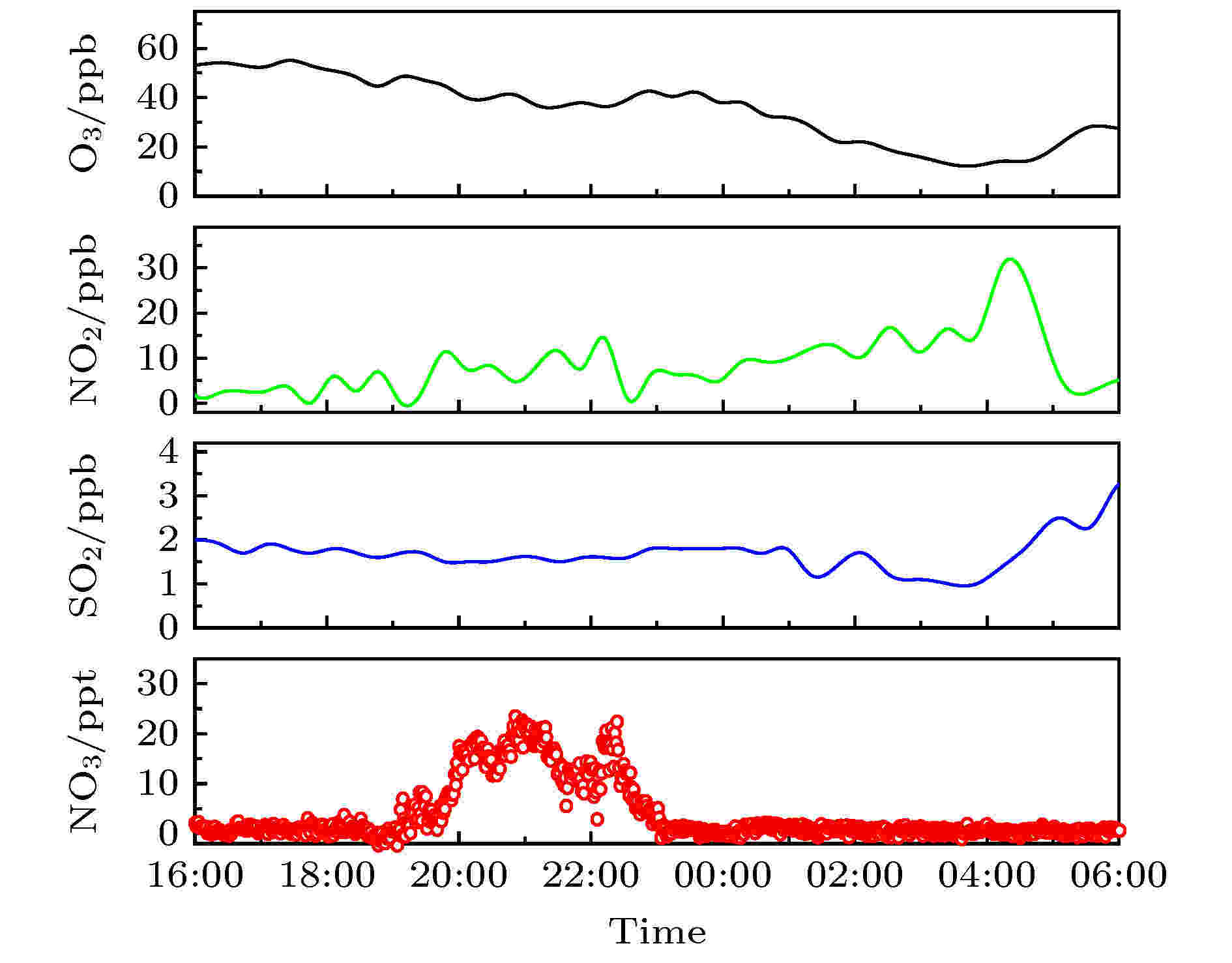 图 7 观测期间大气NO3, O3, NO2, SO2时间序列
图 7 观测期间大气NO3, O3, NO2, SO2时间序列Figure7. Time series of Atmospheric NO3, O3, NO2 and SO2 during observation.
